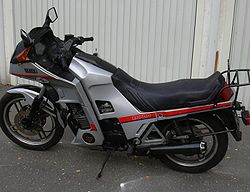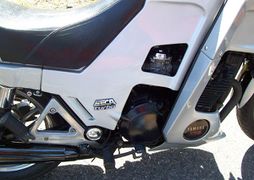Yamaha XJ650L Seca Turbo: review, history, specs
 |
|
| Yamaha XJ650 | |
| Manufacturer | |
|---|---|
| Also called | Maxim |
| Production | 1982 - 1983 |
| Class | Standard |
| Predecessor | Yamaha XJ650 |
| Engine | 653cc in-line four, four-stroke |
| Bore / Stroke | 63.0mm x 52.4mm |
| Compression ratio | 8.2:1 |
| Top Speed | 126 mph (203 km/h) |
| Horsepower | 88.11 HP (65.7 KW) @ 9000RPM |
| Torque | 60.48 ft/lbs (82.0 Nm) @ 7000RPM |
| Ignition | transistorized |
| Spark Plug | NGK BP7ES '80-83 |
| Battery | YUASA 12N12A-4A-1 '80-83 |
| Transmission | Gear box: 5-speed Final Drive: shaft drive (cardan) |
| Final Drive | Shaft |
| Suspension | Front: 36mm Showa 140mm Wheel Travel, Adjustments For Air Pressure Rear: Dual Showa Dampers |
| Brakes | Front: dual disc Rear: expanding brake |
| Front Tire | 3.25-19 |
| Rear Tire | 120/90-18 |
| Wheelbase | 56.89 inches (1445 mm) |
| Seat Height | 30.71 inches (780 mm) |
| Weight | 262.0 kg (wet) |
| Oil Filter | K&N KN-144[1] |
| Recommended Oil | Yamalube 10w-40 |
| Fuel Capacity | 5.02 Gallon (19.00 Liters) |
| Related | Yamaha XJ650 |
| Manuals | Service Manual |
With the appearance of turbocharged Formula One cars in the late 1970s, "turbormania" gripped motorsports and spilled over into everyday life, where the word "turbo" was applied to products from aftershave to vacuum cleaners. In the two wheeled
world, every major manufacturer added a turbocharged model. Honda led the way with the CX500T; Yamaha was more cautious.
Struggle for Supremacy[edit | edit source]
If the turbo represented a low-cost way of boosting the performance of an automobile, the weight and bulk of this bolt-on goody and its attendant plumbing made its advantages less obvious on motorbikes, where large-capacity engines were readily available anyway. But at the time Honda and Yamaha were locked in a bitter struggle for supremacy. The latter couldn't let the former outdo it in terms of high-tech features, even though at the period its finances were under considerable strain.
Keeping Up Appearances[edit | edit source]
Yamaha chose its XJ650L as a starting point. To speed development while keeping costs as low as possible, the marque decided to retain carburetors rather than shifting to Fuel injection. A small-diameter turbocharger minimized throttle lag. Otherwise, the machine was quite conventional, though its aggressive fairing made it look at least like a fuel-injected 750. However, its performance was little improvement on the normally aspirated version, and sales were low.
1982[edit | edit source]
1981 - 1983 Yamaha XJ 650 Turbo[edit | edit source]
My XJ 650 Turbo draw attention at Tokyo Motor Show in 1981. The XJ 650 Turbo, the flashiest of the group, was the simplest, with pressurized carburetors instead of the fuel injection and without the single shock rear suspension the others boasted.
See Also[edit | edit source]
References[edit | edit source]
- ↑ 2019 K&L Supply Co Catalog. K&L Supply Co. 2019.
| ||||||||









